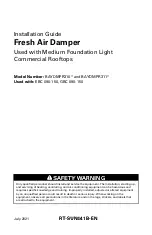
Perimeter gap
»
s1
«
With mortar-based installation the perimeter
gap »s1« must not exceed 225 mm (wall and
ceiling). The perimeter gap »s« must be large
enough so that mortar can be filled in even in case
of thicker walls or ceilings. Be sure to close larger
wall openings or holes beforehand and in a suitable
way, i.e. depending on the type of wall. When there
are larger openings in the solid ceiling slabs, the
dampers must be encased in concrete when the
ceiling section is created. The gap must be large
enough so that mortar can be filled in. We recom-
mend a gap of at least 20 mm (note the minimum
installation opening size). Reinforcement should
meet structural requirements.
Fig. 15: Perimeter gap
1
FKRS-EU
2.1 Mortar
s1 Perimeter gap
Maximum gap widths are based on EN 15882-2. Larger
gaps do not have an adverse effect with regard to fire
protection and are in our opinion not critical.
Mortar-based installation
Cover all openings and control elements of the fire
damper (e.g. with plastic) to protect them from con-
tamination.
If the wall thickness is >115 mm, extend the fire
damper on the installation side with an extension
piece or a spiral duct.
In case of mortar-based installation, the open
spaces between the fire damper casing and the wall
or ceiling slab must be closed off with mortar.
Entrapped air is to be avoided. The mortar bed
depth should be equal to the thickness of the wall
but must be at least 100 mm.
If you install the fire damper as the solid wall or
ceiling slab is being completed, perimeter
gap »s1« is not required. The open spaces between
the fire damper and the wall must be closed off with
mortar; for installation into solid ceiling slabs, con-
crete can be used. Reinforcements should meet
structural requirements.
The mortar bed depth should be equal to the thick-
ness of the wall. If trim panels with appropriate fire
resistance are used, a mortar bed depth of 100 mm
suffices.
Mortar
DIN 1053: Groups II, IIa, III, IIIa; fire protection
mortar of groups II, III
EN 998-2: Classes M 2.5 to M 10 or fire protection
mortar of classes M 2.5 to M 10
Equivalent mortars that meet the requirements of
the above standards, gypsum mortar or concrete
Mineral wool as filling material
Unless otherwise stated in the installation details, min-
eral wool with a gross density of ≥ 80 kg/m³ and a
melting point of ≥ 1000 °C must be used.
Fire-resistant cladding
When you use installation kit WE / WE2, the following
materials are acceptable for the cladding of fire
dampers and ducts:
Promatect® LS35
Promatect® L500
Promatect® AD40
Paroc mineral wool
Paroc Hvac Fire Mat 80BLC (80 kg/m³)
Installation
General installation information
Fire damper Type FKRS-EU
27
Summary of Contents for FKRS-EU
Page 176: ...Fire damper Type FKRS EU 176...
































